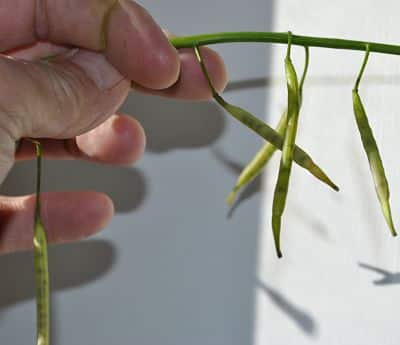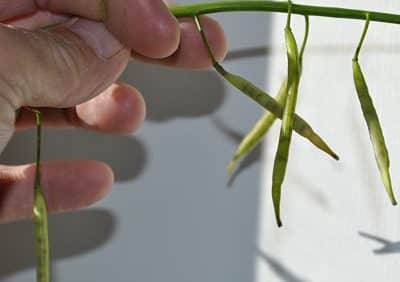September 14, 2011 — Did you have frost last night? Growers with standing canola are wondering whether to swath right away. Before making that decision, note the temperature and duration of the frost.
If you had a heavy frost… below -2 C
Wait 4-6 hours and go out early this afternoon and assess the damage. Check pods for a white, wilted appearance. Pod shatter and pod drop could begin within a day, especially with warm sunny afternoons. If pods are desiccating rapidly, swathing right away will preserve as much yield as possible.
Heavy frost is considered anything below -2 C. The photo below shows canola pods that experienced a -7 C frost that same morning. Within a few hours the pods had turned translucent, a sign of heavy frost damage. Click here for a factsheet with more photos.
If you had a light frost… above -2 C
Hold off swathing. Check this afternoon for wilting to make sure frost damage was not heavier than expected. You may see some speckling on the stem and pods, but this is of no concern as long as the plant is still alive. If no wilting, leave the crop standing and check daily.
What to look for during daily monitoring:
—If the majority of the seeds remain turgid, delay swathing to allow for further seed maturity.
—If the pods are severely damaged and are beginning to desiccate, swath during periods of dew or high humidity to reduce the amount of pod shelling and pod drop.
Why wait to swath? The amount of frost damage depends on various factors including crop stage, degree and length of frost, relative humidity, and presence of rain or dew. In many cases, a light frost will damage the outside of pods but seeds can continue to mature — increasing yield and quality — if the crop is left standing.
Frost and quality. A killing frost will reduce quality, but that can’t be helped — whether you swath today or wait. Immature seeds (moisture content higher than 20%) will be damaged. Seeds with less than 20% moisture will normally escape damage. Green seed is the major downgrade that results from frost.


